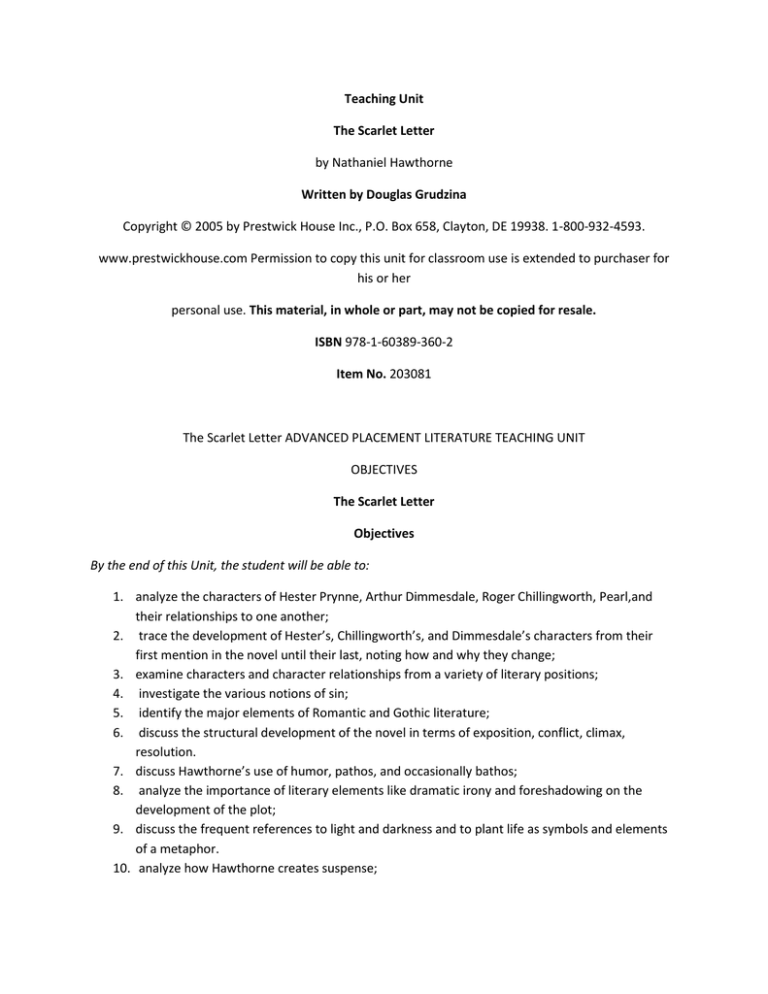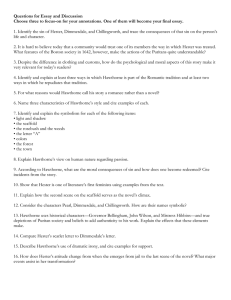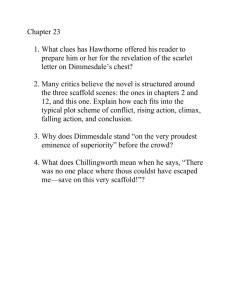Scarlet Letter Reference Material
advertisement

Teaching Unit The Scarlet Letter by Nathaniel Hawthorne Written by Douglas Grudzina Copyright © 2005 by Prestwick House Inc., P.O. Box 658, Clayton, DE 19938. 1-800-932-4593. www.prestwickhouse.com Permission to copy this unit for classroom use is extended to purchaser for his or her personal use. This material, in whole or part, may not be copied for resale. ISBN 978-1-60389-360-2 Item No. 203081 The Scarlet Letter ADVANCED PLACEMENT LITERATURE TEACHING UNIT OBJECTIVES The Scarlet Letter Objectives By the end of this Unit, the student will be able to: 1. analyze the characters of Hester Prynne, Arthur Dimmesdale, Roger Chillingworth, Pearl,and their relationships to one another; 2. trace the development of Hester’s, Chillingworth’s, and Dimmesdale’s characters from their first mention in the novel until their last, noting how and why they change; 3. examine characters and character relationships from a variety of literary positions; 4. investigate the various notions of sin; 5. identify the major elements of Romantic and Gothic literature; 6. discuss the structural development of the novel in terms of exposition, conflict, climax, resolution. 7. discuss Hawthorne’s use of humor, pathos, and occasionally bathos; 8. analyze the importance of literary elements like dramatic irony and foreshadowing on the development of the plot; 9. discuss the frequent references to light and darkness and to plant life as symbols and elements of a metaphor. 10. analyze how Hawthorne creates suspense; 11. explain and identify examples of where the Transcendentalists and Anti-Transcendentalists parted company; 12. debate the rightness or wrongness of the three main characters, considering the multiple concepts of right and wrong as presented in the novel; 13. respond to writing prompts similar to those that will appear on the Advanced Placement English Literature and Composition Exam; 14. respond to multiple choice questions similar to those that will appear on the Advanced Placement English Literature and Composition Exam; 15. offer a close reading of The Scarlet Letter and support all assertions and interpretations with direct evidence from the text, from authoritative critical knowledge of the genre, or from authoritative criticism of the novel. Background Lecture NATHANIEL HAWTHORNE 1804 – 1864 • • Born in Salem, Massachusetts His ancestors were wealthy, influential people. One, William Hathorne, became a judge who persecuted Quakers; another, John Hathorne, sentenced many Salem women to death for witchcraft. Hawthorne was obsessed with the sins of these ancestors who reflected the religious intolerance of the Puritan society. • The death of Hawthorne’s father when Nathaniel was four resulted in a series of unfortunate circumstances that created a lonely childhood for the boy. • • Hawthorne graduated from Bowden College, Maine, and spent the next twelve years in seclusion as he struggled to become a writer. In 1837 he published Twice Told Tales and earned great national fame. His stories won the admiration of Edgar Allan Poe, who considered Hawthorne a genius. • Another contemporary of Hawthorne, Herman Melville, who wrote Moby Dick, became Hawthorne’s close friend. They both reacted to the Transcendental philosophers of the nineteenth century. Many critics refer to this reaction as “Anti-Transcendentalism.” • During his life, Hawthorne was friendly with Transcendentalists Ralph Waldo Emerson and Henry David Thoreau; however, Hawthorne struggled with what he considered the overly optimistic ideas of the Transcendentalists. Evidence of this struggle between a belief in the perfectibility of humanity by following one’s individual conscience and the essentially evil nature of humankind is seen in the ambiguity of The Scarlet Letter. NOTES ON HAWTHORNE’S STYLE, SETTING, AND THEMES 1. In spite of Hawthorne’s opposition to Transcendentalism, he is typical of the nineteenth century romantics. Like them, his stories • • • 2. deal with the strange and the mysterious. involve symbolic imagination. turn to the past for subject matter. Hawthorne focuses his attention on the problem of evil and the nature of sin. He is not a moralist, but like a psychologist, he analyzes the inner world of the human mind and heart; Hawthorne’s stories begin with a simple idea, like guilt. This idea is developed by complex personal relationships between the characters and by symbolism. This symbolic story eventually leads to a probing of the mysteries within the human mind. In The Scarlet Letter, Hawthorne analyzes the effect of one sin on the four main characters who are closely intertwined because of that sin (Hester, Pearl, Dimmesdale, Chillingworth). 3. Hawthorne also examines the question, “What is sin?” Notice how Hawthorne is careful to portray Dimmesdale and Hester’s sin as a crime against civil law but not necessarily against natural law. Beginning with the wild rosebush growing beside the prison door, Hawthorne suggests that Nature might actually sympathize with those whom society has condemned. 4. The Scarlet Letter has unity of place. All action occurs in the center of Boston and the outskirts of this village. There are three scaffold scenes: one in the beginning, one in the middle, and one at the end. In each of these scenes, the four main characters are present, and the changes in each are shown. 5. Hawthorne displays a use of formal language with a precise word choice; although the sentences are long and complex, they are logical and clear. 6. Hawthorne uses images frequently to create the mood and emphasize his ideas. Notice especially the use of plant life to differentiate between those with whom Nature sympathizes and those with whom she does not. Also, notice the use of darkness and shadows, light, the play of sunlight in the forest, etc. 7. The narrator tells most of the story in the form of a summary. Between the passages of explanation by the narrator are poignant, dramatic scenes. At times, Hawthorne interrupts the narration to provide necessary exposition. On other occasions, speaking directly to the reader, Hawthorne offers a choice of interpretations. The reader can decide what is literally true and what is a device to create a supernatural or symbolic effect. This ambiguity is one factor that makes the book so rich to read and discuss, but it also presents problems to readers who feel they need to understand definitively. SETTING OF THE SCARLET LETTER: PURITANISM IN THE MASSACHUSETTS BAY COLONY, 1642 1. Accurate historical references are made to the actual governors, ministers, and practices of the Massachusetts Bay Colony of 1642 – 1650. Hawthorne selected specific details only to develop the mood and the ideas. Students should be reminded that Hawthorne did not live during that time and was not a Puritan. Hawthorne wants the reader to react to these attitudes. 2. Puritan ideas that are alluded to in the novel are as follows: a. Puritanism emerged as a powerful religious and political force in sixteenth-century England. Following Martin Luther’s posting of his ninety-five theses on the door to the church in Wittenberg, the Protestant Reformation spread quickly through Europe. In England, there were Protestants who felt that Henry VIII’s break with Rome over his divorce from Katherine of Aragon did not result in sufficient reform of church doctrine and religious practices in general. These “Puritans,” as they came to be called wanted to return the Church to its “pure” state as the earliest Christians had established it in the first century C.E. The New England Puritans were a radical group who felt that even the English Puritan reforms did not cut deep enough. These were the “pilgrims” who first went to the Netherlands and later sailed to the New World to establish a colony where they could worship as they chose. They did not seek religious freedom as they still persecuted and banished individuals whose beliefs and practices were different from their own. b. The role of both the ministers and the magistrates was to enforce the laws of God. The church and state cooperated in serving God. In fact, the people of the Massachusetts Bay Colony felt they had a covenant with God to establish a community, a “New Jerusalem,” under His laws. c. As a result, all members of this community of God were judges of the faith and works of every other member. They insisted on a lifestyle of self-discipline, which zealously avoided the temptations of the devil and followed the will of God, as expressed in the Ten Commandments and the Bible. The people were completely intolerant of sin. Puritans believed that any sin committed in the community would cause God’s wrath to be visited on them. An illness or misfortune would show God’s disapproval. Puritans looked for sins that had been committed so that the sin could be brought out in the open and the members of the community could express their scorn for that sin. Hawthorne’s scaffold scenes show this public condemnation of sin. These solemn people lived simple lives, dressed in brown, gray, or black, and avoided worldly pleasures. Hawthorne’s descriptions of Puritans are true to this concept; Pearl is the exception. Some historians explain that the cults of witchcraft in this area were a rebellion against this obsession with sin and rigid lifestyle. One practice used to secure the proper discipline of children was to “put out” or transfer children from one family to another. That way, a child could not be spoiled by natural parents. In The Scarlet Letter, the main character, Hester, fears her child will be taken from her. d. Puritan theology valued hard work. Idleness was an invitation to sin (“Idle hands are the devil’s playthings”). In Elizabethan England (established early in The Scarlet Letter as not too far in the past at the opening of the book) the Puritans were responsible for several closings of the theaters, basing their objections on the notion that the performance of plays in the afternoon attracted people away from doing their work. Puritan societies had very few holidays for this same reason. Even Christmas Day had been outlawed in England and the New England Colonies because it encouraged idleness, encouraged licentious behavior, and was—they believed—a remnant of the Catholicism they hoped to abolish. 3. The Puritans felt, however, that humans were too sinful to earn salvation by performing good works or avoiding sin. People could go to Heaven only if they received God’s grace in the process of conversion. During conversion, saving grace enters people’s hearts, and they are released from sin. Some critics feel this happens to one of Hawthorne’s characters at the end of the story. On the other hand, many Puritans—including the New England Puritans—accepted the Calvinist doctrine of predetermination. This meant that the “saved” (those destined to spend eternity in Heaven) had already been determined. One knew whether one was a member of “God’s elect” by being able to avoid sin. Thus, Dimmesdale and Hester are concerned that they may be damned—not because of their sin per se, but because the fact that they sinned indicated that they’d already been damned. Again, the uncertainty as to whether Dimmesdale and Hester are damned or can be redeemed is the source of much of the book’s rich ambiguity. THEMES OF THE SCARLET LETTER: TRANSCENDENTALISM, ANTI-TRANSCENDENTALISM, ROMANTICISM, GOTHICISM 1. Civil law versus Natural law. Marriage is a civil institution governed by the state. Theoretically, it is the solemnized commitment between two people who love one another. Hester, however, claims that even at the time of their marriage she did not love Chillingworth, and Chillingworth admits he violated a law of Nature by marrying a young and beautiful woman who could not love him. Hester and Dimmesdale’s adultery, therefore—if motivated by true love, as the reader is led to believe—is a violation of civil law only. Hester’s marriage, protected by this civil law, is a violation of natural law. 2. The novel explores the nature of sin and the effects of sin on the individual. Sin results in the physical deterioration of the sinner. Acts become sinful not only because they violate others, but also because they violate the individual’s inner laws. Hester feels her unacceptability to others as a result of her sin; she deliberately becomes less beautiful. However, she also develops an inner strength and acceptance of who she is and what she has done. Her strength and usefulness to the community become legendary so that eventually the fact and nature of her sin almost seem to be forgotten by the townspeople. Yet Nature does not seem to condemn Hester for her “sin” as much as it condemns her self-condemnation. Compare the scene in the forest in which the shafts of sunlight fall on Pearl but seem to avoid Hester (Chapter XVI) with the later scene (Chapter XVIII) in which she takes off her scarlet letter, lets her hair down, and admits that her and Dimmesdale’s relationship was indeed “consecrated”. Immediately upon her doing so, the sun breaks out from behind a cloud and shines upon both her and Dimmesdale. BACKGROUND LECTURE Dimmesdale’s sense of guilt and self-defeat lead to physical illness and death. While Hester seems almost to transcend her sin, Dimmesdale succumbs to it. His strongest moment is the third scaffold scene when he is able to admit his sin publicly and foils Chillingworth’s attempt to destroy him. Chillingworth’s inability to “forgive and forget” and his obsession with revenge result in his warped ugliness. When the subject of his obsession and the target of his vengeance die, he has no reason to live and dies as well. Further, he dies frustrated, having failed to destroy his target. 3. Another thematic aspect of The Scarlet Letter is Hawthorne’s reaction to several Romantic ideas. Hawthorne explores the individual’s relationship to society. Humans need to feel a connection to others. Pearl, the child of nature who knows no rules, is isolated from society. To become a part of human society, however, she must share in the sorrow of other humans. Only after joining humanity, is Pearl able to cry. People are not self-reliant. They have a sense of others, which creates their self-image and need for approval. Dimmesdale’s torment comes from his inability to discern a sin against nature from a sin against civil law and his resultant misrepresentation of himself to others. Although Hawthorne has the reader sympathize with Hester, the individual who rebels against society, she lives a solitary life on the edge of a forest. He points out the loneliness and shame that are associated with breaking a law. Questions for Essay and Discussion 1. Identify the sin of Hester, Dimmesdale, and Chillingworth, and trace the consequences of that sin on the person’s life and character. 2. It is hard to believe today that a community would treat one of its members the way in which Hester was treated. What features of the Boston society in 1642, however, make the actions of the Puritans quite understandable? 3. Despite the difference in clothing and customs, how do the psychological and moral aspects of this story make it very relevant for today’s readers? 4. Identify and explain at least three ways in which Hawthorne is part of the Romantic tradition and at least two ways in which he repudiates that tradition. 5. For what reasons would Hawthorne call his story a romance rather than a novel? 6. Name three characteristics of Hawthorne’s style and cite examples of each. 7. • • • • • • • Identify and explain the symbolism for each of the following items: light and shadow the scaffold the rosebush and the weeds the letter “A” colors the forest the town 8. Explain Hawthorne’s view on human nature regarding passion. 9. According to Hawthorne, what are the moral consequences of sin and how does one become redeemed? Cite incidents from the story. 10. Show that Hester is one of literature’s first feminists using examples from the text. 11. Explain how the second scene on the scaffold serves as the novel’s climax. 12. Consider the characters Pearl, Dimmesdale, and Chillingworth. How are their names symbolic? 13. Hawthorne uses historical characters—Governor Bellingham, John Wilson, and Mistress Hibbins—and true depictions of Puritan society and beliefs to add authenticity to his work. Explain the effects that these elements make.


